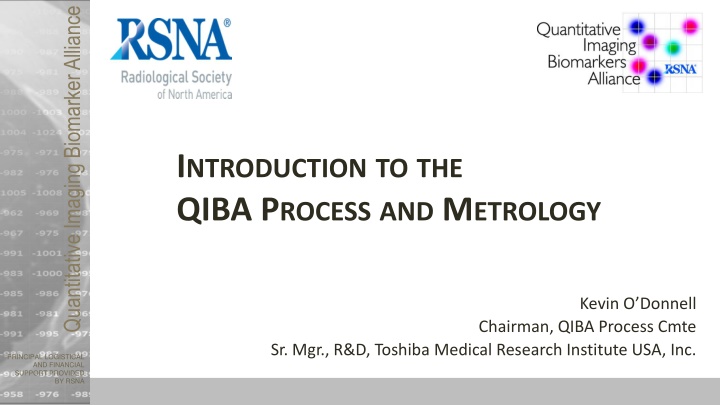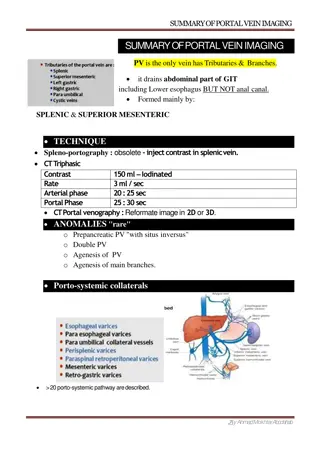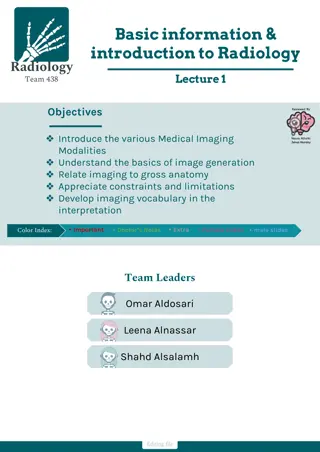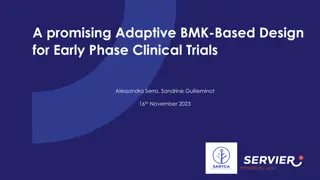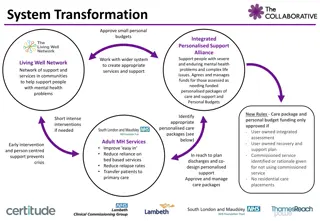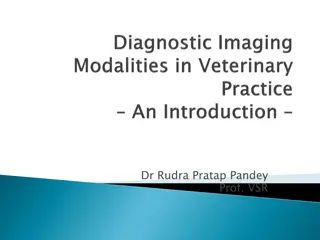Quantitative Imaging Biomarker Alliance Overview" (38 characters)
This content provides an overview of the Quantitative Imaging Biomarker Alliance (QIBA) process and its importance in standardizing imaging biomarkers for clinical use. The QIBA process focuses on selecting translational, transformational, and practical biomarkers that are robust and reliable. Dr. Dan Sullivan's criteria for biomarker selection are also discussed, emphasizing the need for biomarkers to be feasible, collaborative, and impactful on public health. The ultimate goal of QIBA is to industrialize biomarkers and make them readily available for clinical decision-making, benefiting patients and clinicians alike. (499 characters)
Download Presentation

Please find below an Image/Link to download the presentation.
The content on the website is provided AS IS for your information and personal use only. It may not be sold, licensed, or shared on other websites without obtaining consent from the author.If you encounter any issues during the download, it is possible that the publisher has removed the file from their server.
You are allowed to download the files provided on this website for personal or commercial use, subject to the condition that they are used lawfully. All files are the property of their respective owners.
The content on the website is provided AS IS for your information and personal use only. It may not be sold, licensed, or shared on other websites without obtaining consent from the author.
E N D
Presentation Transcript
Quantitative Imaging Biomarker Alliance INTRODUCTION TO THE QIBA PROCESS AND METROLOGY Kevin O Donnell Chairman, QIBA Process Cmte Sr. Mgr., R&D, Toshiba Medical Research Institute USA, Inc. PRINCIPAL LOGISTICAL AND FINANCIAL SUPPORT PROVIDED BY RSNA
Clinical Decisions from Quantitative Imaging Problem Analysis Solution Protocol Reqs Recon Reqs Resolution Reqs Noise Reqs Treat ? 6 Sources of Variance Differences in: - Patient Handling - Acq. Protocols - Reconstruction - Segmentation . . . Segment. Reqs Wait Patient Prep & Operation Reqs Measure = 7 6 Segment. Reqs Goal Calibration Reqs Treat ! When all participating actors conform Wait 2 Measure = 7 RSNA 2016
QIBA Process Apply selection criteria: Translational, Transformational, Practical, Draft Initial Performance Claim Select a Biomarker Academic Research Identify significant sources of variance Estimate achievable repeatability and accuracy Validate underlying assumptions and mechanisms Determine details critical to specify in the Profile Initiate regulatory engagement Coordinate Groundwork Document the agreed parameters and procedures Specify details necessary to be robust in general use Drive out any impeding variance and complexity Make details stable, clear, implementable, testable Draft Profile Clinical Trials & Make Profile available to the community Engage with sites/trials adopting the Profile Converge practice; reduce gratuitous variation Publish Profile Clinical Practice Validate Equipment & Sites Test conformance with QIBA Profile specifications Publish validated products/sites RSNA 2016
QIBA Biomarker Selection Dr. Dan Sullivan, founding chairman of QIBA, proposed 5 characteristics: Translational ready to move from research into clinical care Transformational considerable impact on public health Feasible good chance of success in a reasonable time frame Practical cost-effectively use existing resources where possible Collaborative existing interest across stakeholders QIBAs job is not exploration; QIBAs job is industrialization Make a biomarker robust, reliable and available Bring it the last mile into clinicians hands where it can help patients Too few biomarkers reach that point RSNA 2016
QIBA Profile Structure User View Vendor View Claims: 95% probability that measured change -25% to +30% encompasses the true tumor volume change Requirements: Actor Table Acquisition Device Measurement Software Radiologist Activity Definitions Product Validation Calibration / QA Patient Preparation Image Acquisition / Recon Post-Processing Analysis / Measurement Assessment Procedures: Image Noise and Resolution Tumor Volume Change Variability Site Performance Will it do what I need? Why do you want me to do this? What/who do I need involved? Which of my products are affected? What do I have to do to achieve the Claims? (requirement checklists: procedures, training, performance targets) What do I have to implement; (requirement checklists: features, capabilities, performance targets) How will I be tested? How will I be tested? RSNA 2016
QIBA Profile Stages Progressive levels of stability and confidence Stage Name Stage Meaning Stage Criteria Public Comment Key factors affecting the Claim are described and addressed. Committee of experts believe it practical and expect claimed performance will be achieved. Actor requirements clear & justified Open issues clearly listed Some groundwork may be ongoing Consensus Wider review & consensus; ready for trial use. Public Comments addressed Text reasonably stable Open issues mostly resolved Technically Confirmed Profile is practical to understand and use. Procedures implemented at test site Text stable Open issues resolved Claim Confirmed Claimed performance can be achieved. Performance measured at test site Profile Claims achieved Clinically Confirmed Claimed performance will typically be achieved. Profile Claims achieved in clinical use at multiple sites Note: QIBA doesn t currently evaluate or coordinate transition to this stage RSNA 2016
QIBA Profile Stages Progressive levels of stability and confidence Stage Name Stage Meaning Stage Criteria Public Comment Key factors affecting the Claim are described and addressed. Committee of experts believe it practical and expect claimed performance will be achieved. Actor requirements clear & justified Open issues clearly listed Some groundwork may be ongoing Consensus Wider review & consensus; ready for trial use. Public Comments addressed Text reasonably stable Open issues mostly resolved Technically Confirmed Profile is practical to understand and use. Procedures implemented at test site Text stable Open issues resolved Claim Confirmed Claimed performance can be achieved. Performance measured at test site Profile Claims achieved Clinically Confirmed Claimed performance will typically be achieved. Profile Claims achieved in clinical use at multiple sites Note: QIBA doesn t currently evaluate or coordinate transition to this stage RSNA 2016
QIBA Profile Stages Progressive levels of stability and confidence Stage Name Stage Meaning Stage Criteria Public Comment Key factors affecting the Claim are described and addressed. Committee of experts believe it practical and expect claimed performance will be achieved. Actor requirements clear & justified Open issues clearly listed Some groundwork may be ongoing Consensus Wider review & consensus; ready for trial use. Public Comments addressed Text reasonably stable Open issues mostly resolved Technically Confirmed Profile is practical to understand and use. Procedures implemented at test site Text stable Open issues resolved Claim Confirmed Claimed performance can be achieved. Performance measured at test site Profile Claims achieved Clinically Confirmed Claimed performance will typically be achieved. Profile Claims achieved in clinical use at multiple sites Note: QIBA doesn t currently evaluate or coordinate transition to this stage RSNA 2016
QIBA Profile Stages Progressive levels of stability and confidence Stage Name Stage Meaning Stage Criteria Public Comment Key factors affecting the Claim are described and addressed. Committee of experts believe it practical and expect claimed performance will be achieved. Actor requirements clear & justified Open issues clearly listed Some groundwork may be ongoing Consensus Wider review & consensus; ready for trial use. Public Comments addressed Text reasonably stable Open issues mostly resolved Technically Confirmed Profile is practical to understand and use. Procedures implemented at test site Text stable Open issues resolved Claim Confirmed Claimed performance can be achieved. Performance measured at test site Profile Claims achieved Clinically Confirmed Claimed performance will typically be achieved. Profile Claims achieved in clinical use at multiple sites Note: QIBA doesn t currently evaluate or coordinate transition to this stage RSNA 2016
Quantitative Imaging Biomarker Alliance QIBA METROLOGY CONCEPTS Nancy Obuchowski, PhD Cleveland Clinic Foundation PRINCIPAL LOGISTICAL AND FINANCIAL SUPPORT PROVIDED BY RSNA
Repeatability vs. Reproducibility Repeatability observations in a short time on the same subject under the same conditions; test-retest residual variability reflects subject positioning, image noise, etc. Repeat- ability Reproduc- ibility Measurement procedure same same Measuring device same same or different Reproducibility observations in a short time on the same subject, but the measuring system (facility, operator, and/or measuring device) may differ Operator same same or different Facility same same or different RSNA 2016
95% Confidence Interval (CI) Interval where the true value lies with 95% confidence Gives a practical sense of performance E.g. measured SUVmax = 3.2, and the 95% CI = [ 2.9, 3.5 ] Reflects the estimated bias (interval center) and variability (interval width) Example Usage: Estimated slope of line ( ) 95% CI for = [-3.3, +5.0] Interval contains 1.0, but is wide and contains many values not near 1.0 It would be wise to get more data! RSNA 2016
Cross-sectional vs. Longitudinal Cross-sectional Claim Performance measuring a value (Y) at a single timepoint Tumor glycolytic activity (SUVmax) measurements have a within-subject coefficient of variation (wCV) of 10%. The 95% CI = Y (1.96 Y wCV) Longitudinal Claim Performance measuring change over multiple timepoints For a measured change in shear wave speed of (Y2-Y1), a 95% confidence interval for the true change is (Y2-Y1) 1.96 [(Y1 0.05)2+ (Y2 0.05)2]1/2 Useful characteristic: if bias is consistent, it cancels out RSNA 2016
QIBA Profile Claim Selection Flowchart 1. Type of Claim Longitudinal X-sectional 1a. Same measuring system at all time-points? No Yes 2. Characterize Bias 2. Characterize Bias Unknown Unknown Negligible Known Known Negligible Common 3. Characterize wSD or wCV Scenario J Constant wSD; negligible bias: Construct 95% CI from wSD & estimated RDC Scenario M Constant wSD; bias known: Construct 95% CI from TDI, wSD & estimated RDC Scenario B Constant wSD; bias known: Construct 95% CI from TDI and wSD Scenario G Constant wSD: Construct 95% CI from wSD & estimated RC Scenario A Constant wSD; negligible bias: Construct 95% CI from wSD Constant wSD Scenario D Constant wCV; bias known: Construct 95% CI from TDI and wCV Scenario N Constant wCV; bias known: Construct 95% CI from TDI, wCV & estimated RDC Scenario C Constant wCV; negligible bias: Construct 95% CI from wCV Scenario K Constant wCV; negligible bias: Construct 95% CI from wCV & estimated RDC Scenario H Constant wCV: Construct 95% CI from wCV & estimated RC Constant wCV Scenario F Multiple wCVs; bias known: Construct 95% CIs in multiple claims from different TDIs Scenario E Multiple wCVs; negligible bias: Construct 95% CIs in multiple claims from different wCVs Scenario O Multiple wCVs; bias known: Construct 95% CIs in multiple claims from different TDIs & estimated RDCs Scenario L Multiple wCVs; Negligible bias: Construct 95% CIs in multiple claims from different wCVs & estimated RDCs Scenario I Multiple wCVs: Construct 95% CIs in multiple claims from different wCVs & estimated RCs Multiple wCVs RSNA 2016
Claim Scope Approaches to characteristics that degrade performance Head motion, small lesions, spiculated lesions Control/compensate Profile requires head immobilizer or motion compensation Separate claims for different subpopulations Claim 1: wCV=0.11 for 50mm lesions Claim 2: wCV=0.25 for 10mm lesions Exclude subpopulation from claim Claim holds for non-spiculated lesions RSNA 2016
Conformance Testing Sample Size If claim performance target is wSD=7 (Perc 15 Profile) For actors with an expected performance of wSD=4.0, demonstrating conformance to wSD <7 only needs 13 subjects If claim performance target is wCV=8% (CT Volumetry Profile) For actors with expected wCV=5%, need 17 subjects For actors with expected wCV=6%, need 43 subjects For actors with expected wCV=7%, need 190 subjects Be cautious about setting aggressive performance targets RSNA 2016
Reference Papers: Introduction to Metrology Series Statistical Methods in Medical Research, May 2014: The Emerging Science of Quantitative Imaging Biomarkers: Terminology and Definitions for Scientific Studies and Regulatory Submissions Quantitative Imaging Biomarkers: A Review of Statistical Methods for Technical Performance Assessment Quantitative Imaging Biomarkers: A Review of Statistical Methods for Computer Algorithm Comparisons Statistical Issues in the Comparison of Quantitative Imaging Biomarker Algorithms using Pulmonary Nodule Volume as an Example Meta-Analysis of the Technical Performance of an Imaging Procedure: Guidelines and Statistical Methodology RSNA 2016
